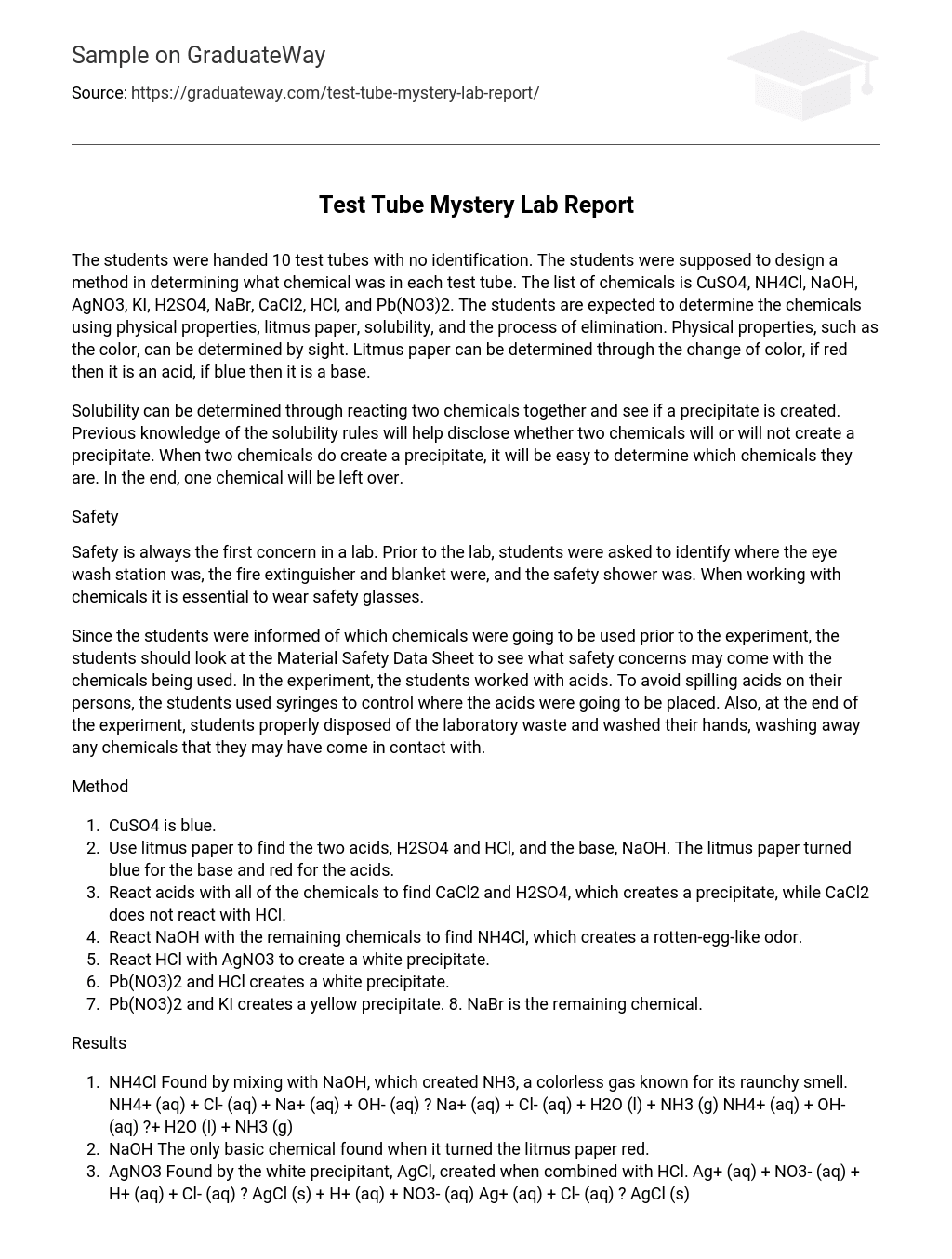The students were handed 10 test tubes with no identification. The students were supposed to design a method in determining what chemical was in each test tube. The list of chemicals is CuSO4, NH4Cl, NaOH, AgNO3, KI, H2SO4, NaBr, CaCl2, HCl, and Pb(NO3)2. The students are expected to determine the chemicals using physical properties, litmus paper, solubility, and the process of elimination. Physical properties, such as the color, can be determined by sight. Litmus paper can be determined through the change of color, if red then it is an acid, if blue then it is a base.
Solubility can be determined through reacting two chemicals together and see if a precipitate is created. Previous knowledge of the solubility rules will help disclose whether two chemicals will or will not create a precipitate. When two chemicals do create a precipitate, it will be easy to determine which chemicals they are. In the end, one chemical will be left over.
Safety
Safety is always the first concern in a lab. Prior to the lab, students were asked to identify where the eye wash station was, the fire extinguisher and blanket were, and the safety shower was. When working with chemicals it is essential to wear safety glasses.
Since the students were informed of which chemicals were going to be used prior to the experiment, the students should look at the Material Safety Data Sheet to see what safety concerns may come with the chemicals being used. In the experiment, the students worked with acids. To avoid spilling acids on their persons, the students used syringes to control where the acids were going to be placed. Also, at the end of the experiment, students properly disposed of the laboratory waste and washed their hands, washing away any chemicals that they may have come in contact with.
Method
- CuSO4 is blue.
- Use litmus paper to find the two acids, H2SO4 and HCl, and the base, NaOH. The litmus paper turned blue for the base and red for the acids.
- React acids with all of the chemicals to find CaCl2 and H2SO4, which creates a precipitate, while CaCl2 does not react with HCl.
- React NaOH with the remaining chemicals to find NH4Cl, which creates a rotten-egg-like odor.
- React HCl with AgNO3 to create a white precipitate.
- Pb(NO3)2 and HCl creates a white precipitate.
- Pb(NO3)2 and KI creates a yellow precipitate. 8. NaBr is the remaining chemical.
Results
- NH4Cl Found by mixing with NaOH, which created NH3, a colorless gas known for its raunchy smell. NH4+ (aq) + Cl- (aq) + Na+ (aq) + OH- (aq) ? Na+ (aq) + Cl- (aq) + H2O (l) + NH3 (g) NH4+ (aq) + OH- (aq) ?+ H2O (l) + NH3 (g)
- NaOH The only basic chemical found when it turned the litmus paper red.
- AgNO3 Found by the white precipitant, AgCl, created when combined with HCl. Ag+ (aq) + NO3- (aq) + H+ (aq) + Cl- (aq) ? AgCl (s) + H+ (aq) + NO3- (aq) Ag+ (aq) + Cl- (aq) ? AgCl (s)
- KI Detected by the yellow precipitate, PbI2, found when combined with Pb(NO3)2. Pb2+ (aq) + NO3-(aq) + NO3-(aq) + 2K+(aq) + 2I-(aq) ? NO3-(aq) + NO3-(aq) + 2K+(aq) + PbI2(s) Pb2+(aq) + 2I-(aq)? PbI2(s)
- CuSO4 Identified by its natural blue color.
- H2SO4 Known as an acid, because it turned the litmus paper blue. Distinguished to be H2SO4, because when reacted with CaCl2, it creates a white precipitate, CaSO4. Ca2+ (aq) + Cl- (aq)+ Cl- (aq) + H+ (aq) + H+ (aq) +SO42- (aq) ? H+ (aq) + H+ (aq) + Cl- (aq)+ Cl- (aq) + CaSO4 (s) Ca2+ (aq) + SO42- (aq) ? CaSO4 (s)
- NaBr Found by the process of elimination, last chemical left standing.
- CaCl2 Found when reacted with H2SO4. (Same as Test Tube 6)
- HCl An acid discovered by turning the litmus paper blue, determined after the other acid (H2SO4) was revealed. 10. Pb(NO3)2 When reacted with HCl, it forms Pb2+ (aq) + NO3-(aq) + NO3-(aq) + H+(aq) + Cl-(aq) ? NO3-(aq) + NO3-(aq) + H+(aq) + PbCl2(s) Pb2+ (aq) + Cl-(aq) ? PbCl2(s)
Conclusion
In conclusion, the experiment did not go as smoothly as I had expected. It was difficult to determine which chemical was NaBr and which chemical was AgNO3, because AgNO3 did not react with HCl as I expected.
Thus leaving me to guess which chemical was which. Also, a significant amount of NaOH and NH4Cl was needed to create a smell, which hindered my experiment, because I had to do several trials in order to receive a slight odor. Unfortunately my tubes were low on chemicals, because they had been used before my use. If I did the experiment again, I would ensure full capacity of chemicals to do my lab, because last time I ran out, which made the determination process harder due to the fact I needed the chemicals to form reactions, without reactions I have no basis for my experiment.
In addition more research on the chemicals would have been helpful to determine which chemical was which, because my prior knowledge was not extensive enough to go through this experiment. The best solution for my issues throughout the experiment is more preparation in understanding the reactions, setting up the station, and going through the experiment. In all, my procedure worked smoothly despite the little hiccups; there simply needed to be more effort in preparing for the lab.





